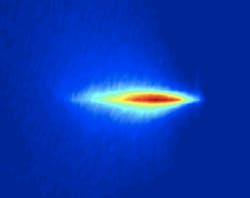FEMTOSECOND LASERS: Laser pulse filaments produce Hawking radiation
It is not often that a tabletop experiment can reproduce effects predicted to normally occur only near the surface of a black hole. A group of Italian and Scottish researchers believe they have done just this—using ultrashort laser pulse filaments to produce observable Hawking radiation.1
Within the event horizon of a gravitational black hole, gravity is strong enough that not even light can escape. But right at the event horizon, virtual photon pairs that spontaneously arise from the vacuum as a result of quantum-mechanical processes (and that would normally quickly combine to become nothing again) can be separated by the hole's gravitational pull, with one photon escaping into space and the other entering the black hole. Due to the peculiarities of quantum mechanics, the entering photon actually reduces the black hole's mass; as a result, the black hole radiates its mass away over time. This radiation is called Hawking radiation.2
The researchers, who are from Universitá degli Studi di Milano, INFN sezione di Milano, Università dell'Insubria, and Università di Milano-Bicocca in Italy, and Heriot-Watt University in Edinburgh, Scotland, use a laser pulse filament to create a traveling refractive-index perturbation (RIP) within fused silica acting as a nonlinear Kerr medium; the local increase in refractive index slows the speed of light so that at some point within the RIP, the speed of light exactly matches the speed of the moving RIP.
As a result, light at that point within the RIP can be both stationary with respect to the RIP and subjected to a very steep refractive-index gradient by it. These two effects combine to imitate a black hole's event horizon: a virtual photon pair that would normally wink out of existence could separate, with one photon entering the RIP and the other leaving it—potentially to be experimentally observed.
The importance of 90°
The laser pulses are produced by a regeneratively amplified neodymium:glass laser at a 10 Hz repetition rate. An axicon with a 20° cone angle produces a Bessel-pulse filament in a 2 cm thick slab of fused silica; the pulse energy is adjustable between 100 and 1200 μJ.
The RIPs are observed using a spectrometer and CCD camera placed at 90° to the path of the pulse filament (see figure). This angle is very important, say the researchers, as it minimizes the capture of any radiation arising from spurious effects.
One spurious effect, Cerenkov radiation, can be separated out because its spectrum is different from that of Hawking radiation. Two others—four-wave mixing (FWM) and self-phase modulation (SPM)—do not occur at 90° (in any case, the researchers took measurements at other angles for a check and found no SPM or FWM). Rayleigh scattering occurs at 90° only for vertically polarized light; the researchers used horizontally polarized light. And finally, the effect of fluorescence was minimized by tuning the pulse's group velocity so that the Hawking spectrum would appear where there was no known fluorescence emission.
The predicted Hawking radiation spectrum peak and bandwidth depend on the refractive-index gradient within the RIP; varying the gradient by varying the peak intensity of the Bessel pulse produced experimental data that fit the predictions.
More work to be done
"Work is continuing on this topic—I would say now even more intensely than ever," says Daniele Faccio, one of the researchers. "We have had a lot of feedback, mostly asking for more details and confirmation of the results. Clearly, a claim such as that put forth in our paper will need further backing and more experiments (hopefully also from other groups), and there are some theoretical details which need to be fully worked out. A major worry is the emission at 90°. We believe this to actually be the key to our success, yet there are some doubts among the community regarding the fact that there should be any emission at all at 90°. Our models say that there is (and the experiments do, too).
"Generally speaking," he adds, "there is a wide consensus regarding that we have indeed seen something very interesting, in the worst case 'very close to Hawking radiation.' But a lot of people want more details before making a final commitment that this is really Hawking radiation. I think that this is perfectly understandable and work is underway to solve this issue, in one way or another."
REFERENCES
1. F. Belgiorno et al., arXiv: 1009.4634v1 [gr-qc], Sept. 23, 2010, to be published in Phys. Rev. Lett.
2. S. Hawking, Nature, 248, 30 (1974).

John Wallace | Senior Technical Editor (1998-2022)
John Wallace was with Laser Focus World for nearly 25 years, retiring in late June 2022. He obtained a bachelor's degree in mechanical engineering and physics at Rutgers University and a master's in optical engineering at the University of Rochester. Before becoming an editor, John worked as an engineer at RCA, Exxon, Eastman Kodak, and GCA Corporation.
